
.
If you have any comments, observations, or questions about what you read here, remember you can always Contact Me
All content included on this site such as text, graphics and images is protected by U.S and international copyright law.
The compilation of all content on this site is the exclusive property of the site copyright holder.
The days when meat was delivered as a side of beef or half a pig are just about vanished from the average supermarket. Today's meat arrives already broken down into primal cuts. What we customarily see in the meat case are tidy chops, some roasts, neat spare ribs. What about the rest of the pig? Well, today's your chance to find out. Today at the Howell Living History Farm in Titusville, New Jersey visitors can see how pigs are made into meat. Not the slaughtering - that might bea little too graphic for most folks. The three pigs had been taken to a butcher, slaughtered, cleaned, and brought to the farm as six sides (and three heads. As the old saying goes, "Use everything but the squeal.") It's an interesting program.

.
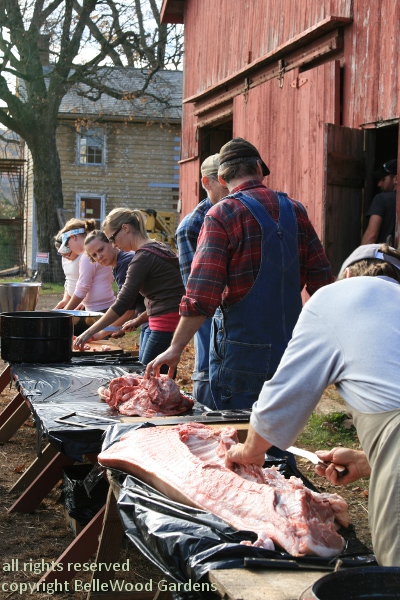
The work line is set up. The carcass arrives on the right, gets cut up and as it reaches the other end the fat is cut up to be rendered into lard and the meat scraps will become sausage.
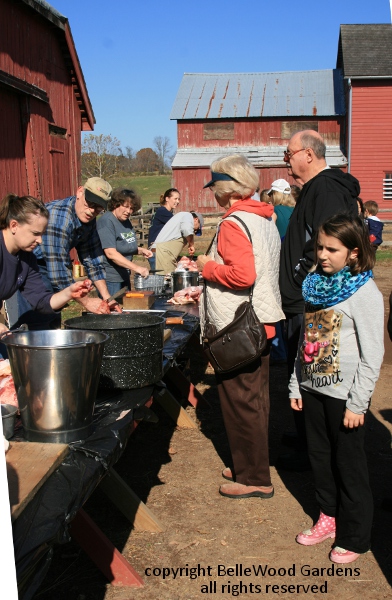
The audience had people of all ages. Some were there to recall the days when their family lived on a farm, raised and butchered their own livestock. There were families, who wanted their children to see where the meat on their table came from - not antiseptic little packages but once living animals. One boy, with a disgusted look on his face muttered, "I'm never going to eat bacon again." Whereupon one of the presenters gently asked, "Where did you think it came from?" I would venture to guess that he simply hadn't thought about it. So many people don't.

It was clear to see that this is something the presenters have done numerous times before. They had all the tools - an array of knives, sharpening steels, a couple of saws, a couple of cleavers, a massive wooden cutting board cross-hatched with marks where a cleaver had separated hock from foreleg. A fresh ham was neatly separated from the hind quarter. The hams, fresh sides for bacon, and some sausage would go to a smoke house in Lancaster, Pennsylvania for curing.

.
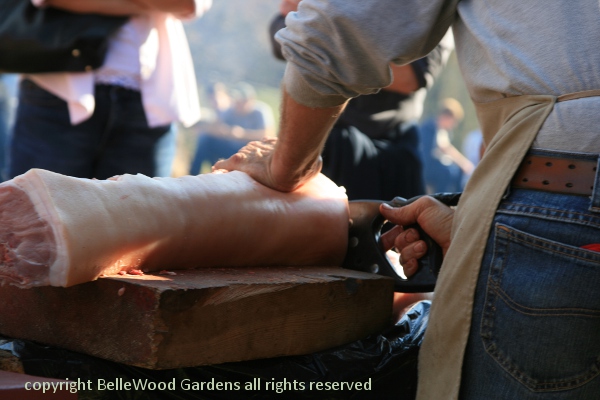
The individual chops were sawn apart off the backbone. While the process might be unfamiliar, so far the results look like what we see in the supermarket's meat case.
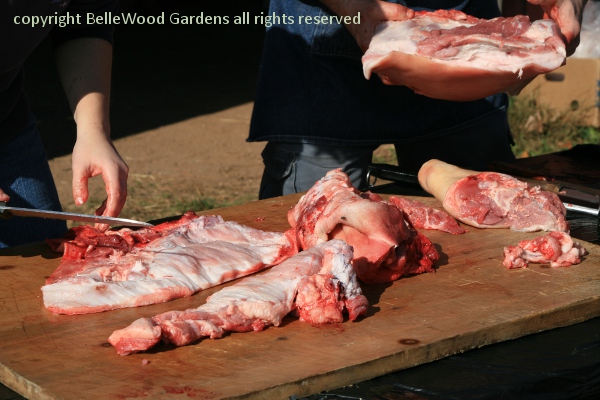
Here's where it gets interesting. The meat scraps (and some better pieces too) are being trimmed, then ground up to be turned into sausage. The heads were skinned and defleshed, same with the fore- and hind shanks. The meat needs to be cubed to easily go through the grinder. Someone told me that the younger woman on the line had first been part of the event as a girl. Now her daughters were cutting the meat and fat just as she had.

.

The quantity of meat from three pigs that's going to become sausage needs machinery. Today it's a 3hp "hit and miss" engine with a long belt that powers the meat grinder. This type of engine doesn't have to run at full output. With this small a load it was probably only chugging away a 1 1/2 horsepower. The meat is ground once.
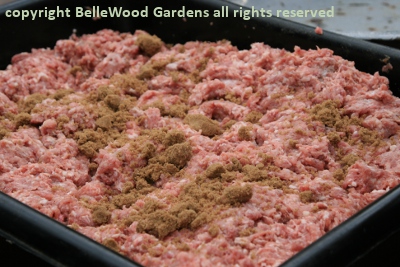
Then the seasonings are added

and it is all put through the grinder again, incorporating the seasonings with the meat
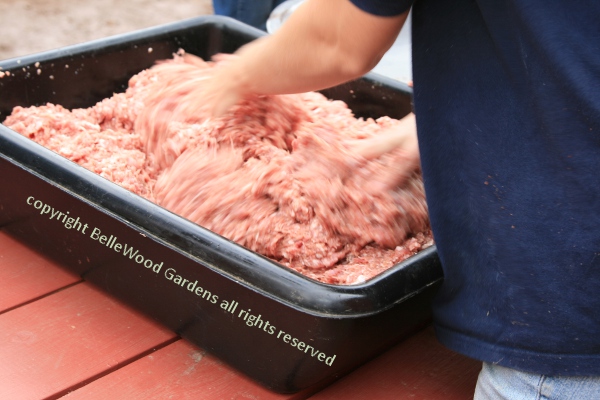
with the final mixing accomplished by hand.
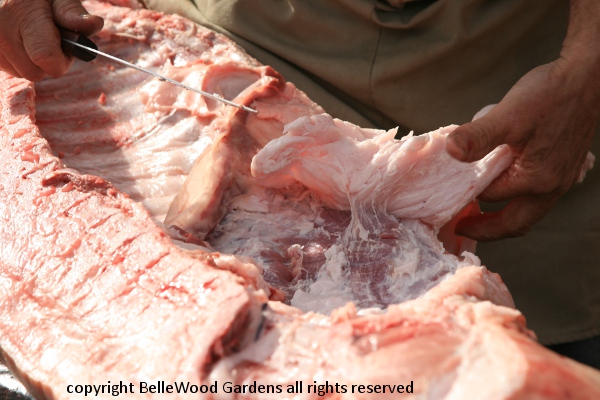
The finest quality fat is called leaf lard, and it is the flaky fat that's around the kidneys.
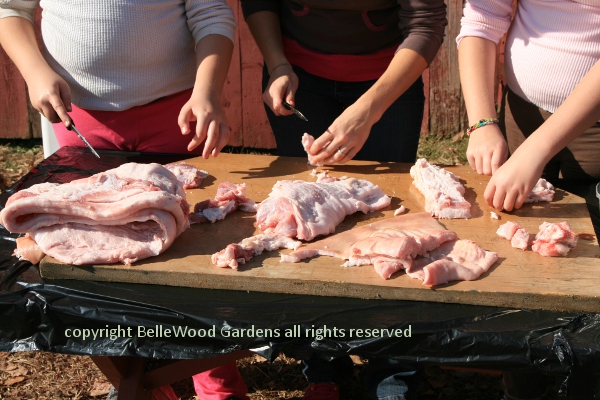
But today, with the time pressure of butchering three pigs while answering questions from the audience, all the fat is being rendered down together.

This is a special stove with a kettle insert. The kettle fits snuggly on the top of the stove but there's space between the kettle and the wall of the stove. Heat circulates, smoke rises through the chimney, and the fat cooks out of the scraps.

See it bubbling away. After the fat is rendered the liquid is poured off. The scraps left behind will be pressed to get every last bit. And the crunchy browned bits that remain are called cracklings, and are delicious! Lard has so many uses. It makes the most delicate, flaky pastry. Potatoes fried in lard are delectable. And it can be used, with lye added, to make soap. Waste not, want not.
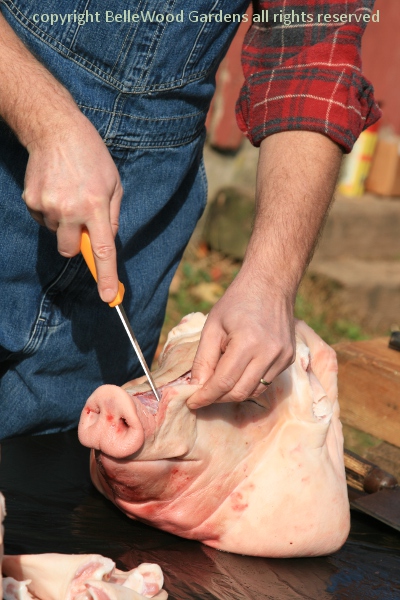
Every last bit of the pig is utilized. Meaty scraps from the head that are not used for sausage will become scrapple. The trimmed bones with little bits of meat are boiled until the meat falls off the bones, and falls apart. Along with liver (but not too much or it affects the flavor), heart, perhaps the tongue - the scraps become scrapple, a Pennsylvania Dutch culinary specialty. "But," the workers told me, "if you buy scrapple you really need to know your butcher. Because it can be very good, or really bad."
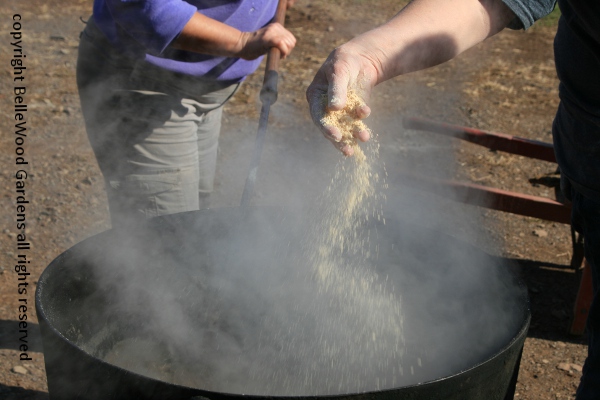
Along with the shreds of meat and the broth from the boiled bones scrapple has cornmeal and flour added a handful at a time, constantly stirred, until it begins to thicken. Then seasoned with salt and black pepper, and stirred some more before pouring into pans to cool and solidify.
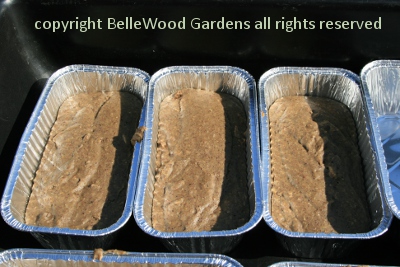
It's a breakfast item. To serve, the scrapple is sliced, then fried, and plated with a runny yolked egg on top. I confess, it's not my thing. Perhaps you need to be raised to it, to enjoy scrapple. It was not available in Brooklyn, New York where I grew up.
There's more to a pig than chops and roasts and bacon. And more than sausage and scrapple.
There's head cheese, which is made from the pig's head but has nothing to do with cheese. In its finished form head cheese is a terrine, with the meat suspended in a jellied aspic. Souse is much the same, but with some vinegar, for a sharper flavor. Chitlins are made from the cleaned intestines, which also provide sausage casings. Hog maw is the stomach, cleaned and stuffed with cubed potatoes and loose sausage meat, cabbage, and onion, and spices, then boiled. Sort of like haggis, but using a pig's stomach, not that of a sheep, and without the oatmeal. Once upon a time Cork, in Ireland, was a center for slaughtering animals to provide meat to the British military. The slaughterhouse workers could buy the offal quite cheaply. As you can imagine all sorts of recipes were developed, and it was in Cork that I had drisheen, a blood pudding.
Everything but the squeal.
Back to Top
Back to November 2013